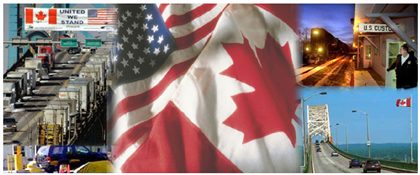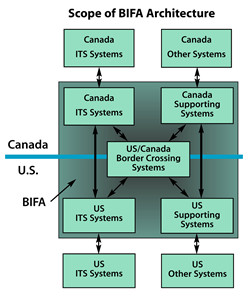Printable
Version [PDF 190KB]
![]() You will need the Adobe
Acrobat Reader to view this PDF.
You will need the Adobe
Acrobat Reader to view this PDF.

Border Information Flow Architecture
Since 1995, trade between Canada and the United States has doubled in inflation-adjusted dollars, growing more quickly than the overall economy. Truck traffic has grown dramatically, with 6.9 million trucks crossing from Canada into the United States in 2004, up from 5.1 million in 1995. Nearly two-thirds of the value of goods traded across the border are transported by truck.1
Numerous government agencies operate at or near U.S.-Canada border crossings. In the post September 11 border environment, both the United States and Canada are implementing new processes, procedures, and technologies to enhance security and improve the efficiency of goods movement. Lack of coordination among these various agencies could result in the deployment of technology that is not interoperable, is redundant, and could impede efficient operations.
The Transportation Border Working Group, a bi-national group that works to enhance coordination and planning between the United States and Canada, identified collaboration on the implementation of border technology as one of its key priorities. To advance this priority, the U.S. Department of Transportation (USDOT), Federal Highway Administration (FHWA) and Transport Canada, in partnership with state and provincial transportation organizations, regional planning organizations, and other federal agencies, initiated the development of a Border Information Flow Architecture (BIFA). The process to develop BIFA was similar to the one used to develop regional intelligent transportation systems (ITS) architectures, described in Regional ITS Architecture Guidance—Developing, Using, and Maintaining an ITS Architecture for Your Region (http://ntl.bts.gov/lib/jpodocs/repts_te/13598.pdf).

sponsorship from the U.S. DOT ITS Joint Program Office and support
from the National ITS Architecture Team.
What is BIFA?
BIFA supports the planning, development, and implementation of ITS and other technology-based solutions at the U.S.-Canada border. It does this by identifying agencies at or near the border and mapping information flows between them. A key feature of BIFA is that its definition of ITS projects includes technologies used by non-transportation stakeholders such as U.S. and Canadian customs agencies.
Completed in December 2005, BIFA is comparable to a regional ITS Architecture, which is defined by FHWA as a “regional framework for ensuring institutional agreement and technical integration for implementing ITS projects.” BIFA is grounded in two general versions of ITS architecture developed at national levels:
- U.S. National ITS Architecture Version 5.1. A description of this architecture is located at http://www.iteris.com/itsarch.
- ITS Architecture for Canada Version 1.1. A description of this architecture is located at http://www.its-sti.gc.ca/Architecture/english/static/content.htm.
As shown in the figure, the scope of the BIFA architecture includes:
- Systems (also called elements in regional ITS architecture) that operate at the border and their interfaces. Examples of these types of elements are a bridge or tunnel transportation operations center (TOC) and U.S. border inspection systems.
- U.S. or Canadian systems or elements that interface with cross-border systems and/or share direct interfaces across the border. Examples of these types of elements are a State Department of Transportation Traffic Management Center (TMC) interface with a bridge or tunnel TOC or an interface with a Canadian Provincial Ministry of Transport TMC.
- The elements at the “edge” of the architecture that interface with those that have no cross-border interfaces. An example of this is an interface between a State Department of Transportation TMC and another State TMC.

Next Steps
Agencies using or planning to use BIFA are:
- Whatcom County Council of Governments and the British Columbia Ministry of Transportation plan to use BIFA to develop a project architecture for their region's bi-national Advanced Traveler Information System Data Management initiative.
- A New York State DOT/I-87 group is using BIFA to develop a project architecture for a queue warning/ border wait-time system at the Lacolle/Champlain crossing.
- The Ontario Ministry of Transportation used BIFA in the development of a concept of operations and regional ITS architecture for the Intelligent Border Crossing project in Ontario.
FHWA and Transport Canada continue to encourage border stakeholders to work collaboratively to plan for and deploy technology solutions based on BIFA. The use of BIFA can increase interoperability and ultimately improve the movement of goods and people at U.S.-Canada border crossings. Indicators of success include:
- Reduction in unpredictability and inconsistency of traffic flow through U.S.-Canada borders.
- Improved accessibility to truck and freight information by all parties involved in the movement of goods through borders.
- Reduction in the number of redundant inspections for commercial vehicles on the same trip.
- Reduction in border wait and crossing time for passenger and commercial vehicles.
Additional information about the BIFA architecture is located at http://www.iteris.com/itsarch/bifa.
|
April 2006 FHWA-HOP-06-098 EDL 14283 |

|

|
|
Office of Freight Management and Operations, 400 7th Street, SW, Room 3401, Washington, D.C. 20590
https://ops.fhwa.dot.gov/freight/, Toll-free help-line 866-367-7487 |
||